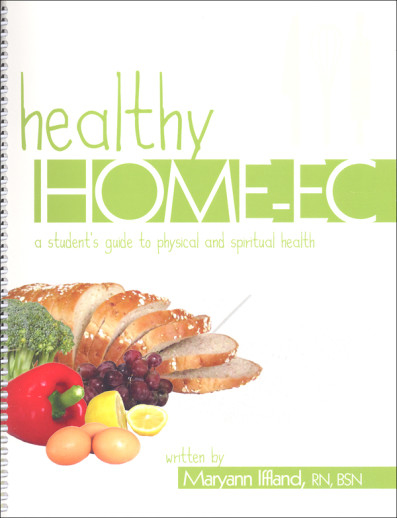We use cookies to make your experience better. To comply with the new e-Privacy directive, we need to ask for your consent to set the cookies. Learn more.
Healthy Home-Ec: A Student's Guide to Physical and Spiritual Health
Teaching young people the value of proper nutrition is a valuable endeavor that is often overlooked. If you have a desire to teach your sons and daughters proper, whole foods nutrition, meal planning and cooking, this one semester course may be perfect to meet your needs. And if you were never taught the benefits of and how to prepare whole, organic, or living foods, you might be interested in learning right along with them!
Designed for independent study, your role as a parent/instructor is to assist the student as needed, teach them location (and proper use) of kitchen equipment, and record their grade. Instructor overview, grade sheets (divided into 2 nine-week charts), required equipment and supplies, optional equipment and supplies, along with pantry and refrigerator staple items are provided before the course is initiated. As a side note, required equipment and supplies typically are common kitchen items, although you may need to add a food processor, grain mill, and a powerful blender.
Weekly lessons are well organized and easy to implement. Beginning with a shopping list for the week, the lessons are organized into a five days per week schedule. The first day incorporates a scripture memory verse and related reading, and weekly homework assignments. Consecutive days provide brief review and meal preparation activity, which includes an ingredient listing and step by step instructions. Each meal has a dedicated day-for example: Tuesday breakfast, Wednesday lunch, Thursday dinner, and Friday focused on healthy desserts or side dishes. Most days also include related dinner discussion questions or starters. Throughout the course of study, students will learn the rationale for eating healthy, economics of food choices and shopping, proper table etiquette, grinding wheat for bread, planting an herb garden, canning, and diverse palates for healthy eating. Appendix includes two exams to be completed, one at the end of 9 weeks and the other at 18 weeks. Answer key is also included. An excellent, introduction to home-economics for families striving to live nutritionally well. Considered one semester, I would pair it with Light Speed Nutrition (#051984) DVDs for more nutrition instruction at the high school level. Spiral Bound. 267 pgs. ~Deanne
| Product Format: | Paperback |
|---|---|
| Brand: | Morris Publishing |
| Author: | Maryann Iffland, RN, BSN |
| Grades: | 7-AD |
| ISBN: | 9780615822457 |
| Length in Inches: | 11 |
| Width in Inches: | 9 |
| Height in Inches: | 1 |
| Weight in Pounds: | 1.65 |

